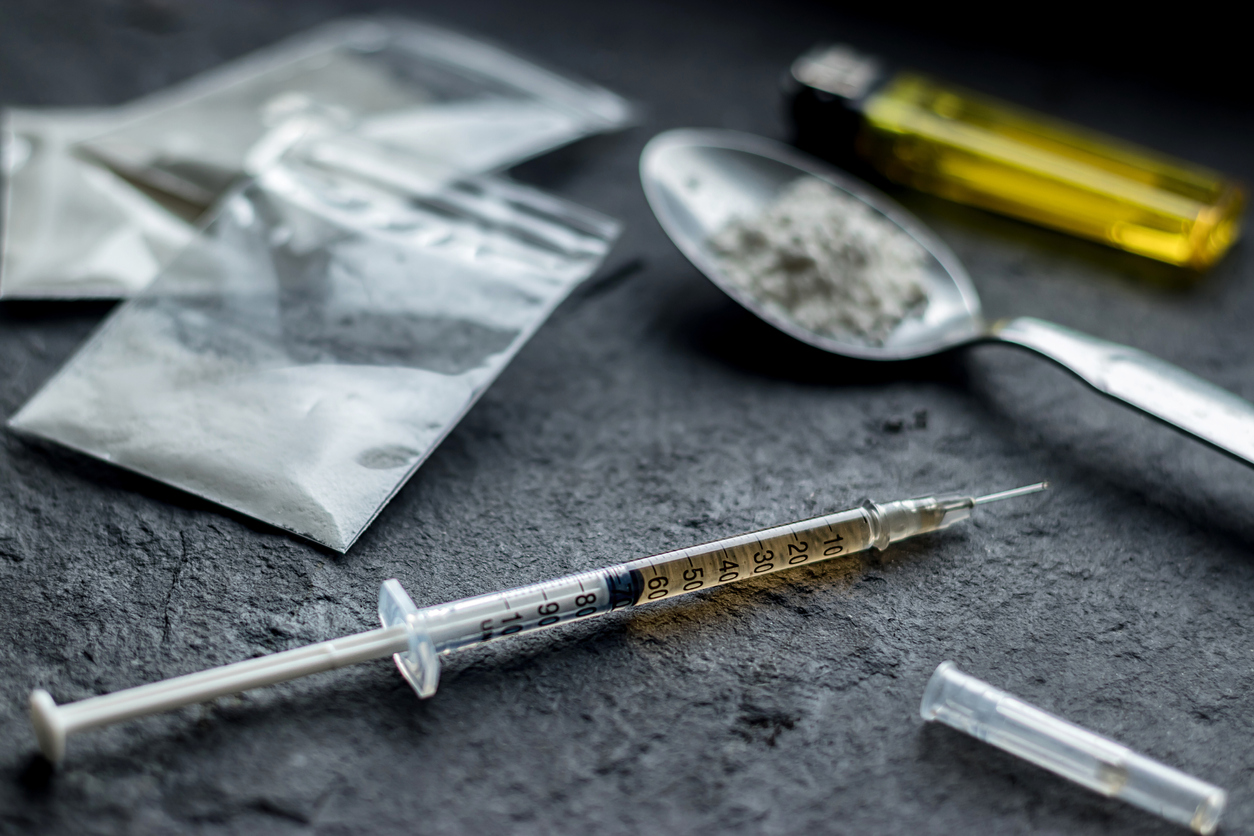Heroin
What is Heroin?
Heroin is an opioid drug made from morphine, a natural substance taken from the seed pod of the various opium poppy plants grown in Southeast and Southwest Asia, Mexico, and Colombia. Heroin can be a white or brown powder, or a black sticky substance known as black tar heroin.
How Do People Use Heroin?
People inject, sniff, snort, or smoke heroin. Some people mix it with crack cocaine, a practice called speedballing.
What Are the Effects of Heroin?
Heroin enters the brain rapidly and binds to opioid receptors on cells located in many areas, especially those involved in feelings of pain and pleasure and in controlling heart rate, sleeping, and breathing.
Short-term Health Effects include:
People who use heroin report feeling a “rush” (a surge of pleasure, or euphoria). However, there are other common effects, including:
- dry mouth
- warm flushing of the skin
- heavy feeling in the arms and legs
- nausea and vomiting
- severe itching
- clouded mental functioning
- going “on the nod,” a back-and-forth state of being conscious and semiconscious
long-term health effects include:
People who use heroin over the long term may develop:
- insomnia
- collapsed veins for people who inject the drug
- damaged tissue inside the nose for people who sniff or snort it
- infection of the heart lining and valves
- abscesses (swollen tissue filled with pus)
- constipation and stomach cramping
- liver and kidney disease
- lung complications, including pneumonia
- mental health disorders such as depression and antisocial personality disorder
- sexual dysfunction for men
- irregular menstrual cycles for women
Other potential health effects include:
Heroin often contains additives, such as sugar, starch, or powdered milk, that can clog blood vessels leading to the lungs, liver, kidneys, or brain, causing permanent damage. Also, sharing drug injection equipment and having impaired judgment from drug use can increase the risk of contracting infectious diseases such as HIV and hepatitis (see “Injection Drug Use, HIV, and Hepatitis”).
Researchers are studying the long-term effects of opioid addiction on the brain. Studies have shown some loss of the brain’s white matter associated with heroin use, which may affect decision-making, behavior control, and responses to stressful situations.
Is Heroin Addictive?
Heroin is highly addictive. People who use it regularly often develop a tolerance, which means that they need higher and/or more frequent doses of the drug to get the desired effects. A substance use disorder (SUD) is when continued use of the drug causes issues, such as health problems and failure to meet responsibilities at work, school, or home. An SUD can range from mild to severe, the most severe form being addiction.
Those who are addicted to opioids and stop using the drug abruptly may have severe withdrawal. Withdrawal symptoms—which can begin as early as a few hours after the drug was last taken—include:
- restlessness
- severe muscle and bone pain
- sleep problems
- diarrhea and vomiting
- cold flashes with goose bumps (“cold turkey”)
- uncontrollable leg movements (“kicking the habit”)
- severe heroin cravings
How Is Heroin Addiction Treated?
A range of treatments including medicines and behavioral therapies are effective in helping people stop. It’s important to match the best treatment approach to meet specific needs of each individual patient.
There are medicines being developed to help with the withdrawal process. The FDA approved lofexidine, a non-opioid medicine designed to reduce opioid withdrawal symptoms.
Medicines to help people stop using opioids include buprenorphine and methadone. They work by binding to the same opioid receptors in the brain as heroin, but more weakly, reducing cravings and withdrawal symptoms. Another treatment is naltrexone, which blocks opioid receptors and prevents opioid drugs from having an effect. A NIDA study found that once treatment is initiated, both a buprenorphine/naloxone combination (Suboxone) and an extended-release naltrexone formulation (Vivitrol) are similarly effective in addiction. Because full detoxification is necessary for treatment with naloxone, initiating treatment among active users was difficult, but once detoxification was complete, both medications had similar effectiveness.
Behavioral therapies for heroin addiction include methods called cognitive-behavioral therapy and contingency management. Cognitive-behavioral therapy helps modify the patient’s drug-use expectations and behaviors and helps effectively manage triggers and stress. Contingency management provides motivational incentives, such as vouchers or small cash rewards for positive behaviors such as staying drug-free. These behavioral treatment approaches are especially effective when used along with medicines.
Points to Remember
- Heroin is an opioid drug made from morphine, a natural substance taken from the seed pod of various opium poppy plants.
- Heroin can be a white or brown powder, or a black sticky substance known as black tar heroin.
- People inject, sniff, snort, or smoke heroin. Some people mix heroin with crack cocaine, called speedballing.
- Heroin enters the brain rapidly and binds to opioid receptors on cells located in many areas, especially those involved in feelings of pain and pleasure and in controlling heart rate, sleeping, and breathing.
- People who use heroin report feeling a “rush” (or euphoria). Other common effects include dry mouth, heavy feelings in the arms and legs, and clouded mental functioning.
- Long-term effects may include collapsed veins, infection of the heart lining and valves, abscesses, and lung complications.
- Research suggests that misuse of prescription opioid pain medicine is a risk factor for starting heroin use.
- A person can overdose on heroin. Naloxone is a medicine that can treat a heroin overdose when given right away, though more than one dose may be needed.
- Heroin can lead to addiction, a form of substance use disorder. Withdrawal symptoms include severe muscle and bone pain, sleep problems, diarrhea and vomiting, and severe heroin cravings.
- A range of treatments including medicines and behavioral therapies are effective in helping people stop heroin use. However, treatment plans should be individualized to meet the needs of the patient.
Source: National Institute on Drug Abuse; National Institutes of Health; U.S. Department of Health and Human Services.
NIDA. 2021, June 1. Heroin DrugFacts. Retrieved from https://nida.nih.gov/publications/drugfacts/heroin on 2022, November 27

Prescription Opioids and Heroin
Prescription opioid pain medicines such as OxyContin® and Vicodin® have effects similar to heroin. Research suggests that misuse of these drugs may open the door to heroin use. Data from 2011 showed that an estimated 4 to 6 percent who misuse prescription opioids switch to heroin and about 80 percent of people who used heroin first misused prescription opioids. More recent data suggest that heroin is frequently the first opioid people use. In a study of those entering treatment for opioid use disorder, approximately one-third reported heroin as the first opioid they used regularly to get high.
This suggests that prescription opioid misuse is just one factor leading to heroin use. Read more about this intertwined problem in our Prescription Opioids and Heroin Research Report.
Read more about this intertwined problem in Prescription Opioids and Heroin Research Report.
Injection Drug Use, HIV, and Hepatitis
People who inject drugs such as heroin are at high risk of contracting the HIV and hepatitis C (HCV) virus. These diseases are transmitted through contact with blood or other bodily fluids, which can occur when sharing needles or other injection drug use equipment. HCV is the most common bloodborne infection in the Unites States. HIV (and less often HCV) can also be contracted during unprotected sex, which drug use makes more likely.
Can a person overdose on heroin?
Yes, a person can overdose on heroin. A heroin overdose occurs when a person uses enough of the drug to produce a life-threatening reaction or death. Heroin overdoses have increased in recent years.
When people overdose on heroin, their breathing often slows or stops. This can decrease the amount of oxygen that reaches the brain, a condition called hypoxia. Hypoxia can have short- and long-term mental effects and effects on the nervous system, including coma and permanent brain damage.
How can an heroin overdose be treated?
Naloxone is a medicine that can treat an opioid overdose when given right away. It works by rapidly binding to opioid receptors and blocking the effects of heroin and other opioid drugs. Sometimes more than one dose may be needed to help a person start breathing again, which is why it’s important to get the person to an emergency department or a doctor to receive additional support if needed.
Naloxone is available as an injectable (needle) solution and nasal sprays (NARCAN® Nasal Spray and KLOXXADO®). Friends, family, and others in the community can use the nasal spray versions of naloxone to save someone who is overdosing.
The rising number of opioid overdose deaths has led to an increase in public health efforts to make naloxone available to at-risk persons and their families, as well as first responders and others in the community. Some states have passed laws that allow pharmacists to dispense naloxone without a prescription from a person’s personal doctor.
Read more about Naloxone.
Struggling with a Heroin Addiction?
If you or a loved one is struggling with a Heroin Addiction, call Solstice Health & Wellness to schedule an appointment, or to learn more about addiction recovery services, contact us.
*Please do not submit any Protected Health Information (PHI).

